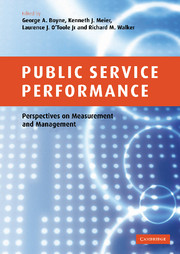Book contents
- Frontmatter
- Contents
- List of figures
- List of tables
- Notes on contributors
- 1 Introduction
- 2 Subjective and objective measures of organizational performance: An empirical exploration
- 3 All measures of performance are subjective: More evidence on US federal agencies
- 4 A qualitative evaluation of public sector organizations: Assessing organizational performance in healthcare
- 5 Quantitative approaches towards assessing organizational performance
- 6 Consequences of goal ambiguity in public organizations
- 7 Performance control and public organizations
- 8 Bureaucratic red tape and organizational performance: Testing the moderating role of culture and political support
- 9 All that glitters is not gold: Disaggregating networks and the impact on performance
- 10 Network evolution and performance under public contracting for mental health services
- 11 The design and management of performance-based contracts for public welfare services
- 12 Outsourcing government information technology services: An Australian case study
- 13 International comparisons of output and productivity in public service provision: A review
- 14 Public management and government performance: An international review
- 15 What drives global e-government? An exploratory assessment of existing e-government performance measures
- 16 Public management and organizational performance: An agenda for research
- Index
- References
2 - Subjective and objective measures of organizational performance: An empirical exploration
Published online by Cambridge University Press: 22 September 2009
- Frontmatter
- Contents
- List of figures
- List of tables
- Notes on contributors
- 1 Introduction
- 2 Subjective and objective measures of organizational performance: An empirical exploration
- 3 All measures of performance are subjective: More evidence on US federal agencies
- 4 A qualitative evaluation of public sector organizations: Assessing organizational performance in healthcare
- 5 Quantitative approaches towards assessing organizational performance
- 6 Consequences of goal ambiguity in public organizations
- 7 Performance control and public organizations
- 8 Bureaucratic red tape and organizational performance: Testing the moderating role of culture and political support
- 9 All that glitters is not gold: Disaggregating networks and the impact on performance
- 10 Network evolution and performance under public contracting for mental health services
- 11 The design and management of performance-based contracts for public welfare services
- 12 Outsourcing government information technology services: An Australian case study
- 13 International comparisons of output and productivity in public service provision: A review
- 14 Public management and government performance: An international review
- 15 What drives global e-government? An exploratory assessment of existing e-government performance measures
- 16 Public management and organizational performance: An agenda for research
- Index
- References
Summary
Introduction
Governments around the globe now seek to judge the performance of their public services. This has given rise to the introduction of a range of complex and sophisticated regimes to provide information to politicians, managers and the public on organizational success or failures. Examples include an index of measures of performance of Chinese cities (China Daily 2004), the Comprehensive Performance Assessment in English local government (Audit Commission 2002), the Government Performance Results Act 1992 in the US, the Service Improvement Initiative in Canada, the Putting Service First scheme in Australia, Strategic Results Area Networks in New Zealand, Management by Results in Sweden, and Regulation of Performance Management and Policy Evaluation in the Netherlands (Pollitt and Bouckaert 2004). Researchers have increasingly turned their attention to public service performance (e.g., see the Symposium edition of Journal of Public Administration Research and Theory 2005 (Boyne and Walker 2005), on the determinants of performance in public organizations). Despite such progress, a persistent problem for public management researchers and practitioners has been the conceptualisation and measurement of performance.
Previous research has shown that organizational performance is multifaceted (Boyne 2003; Carter et al. 1992; Quinn and Rohrbaugh 1983; Venkatraman and Ramanujuam 1986). This is because public organizations are required to address a range of goals, some of which may be in conflict. Consequently, public organizations are obliged to focus attention on multiple dimensions of performance. Boyne's (2002) review of these dimensions isolated five conceptual categories – outputs, efficiency, effectiveness, responsiveness and democratic outcomes.
- Type
- Chapter
- Information
- Public Service PerformancePerspectives on Measurement and Management, pp. 14 - 34Publisher: Cambridge University PressPrint publication year: 2006
References
- 107
- Cited by

